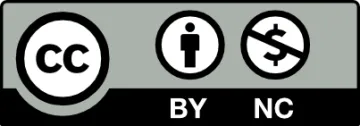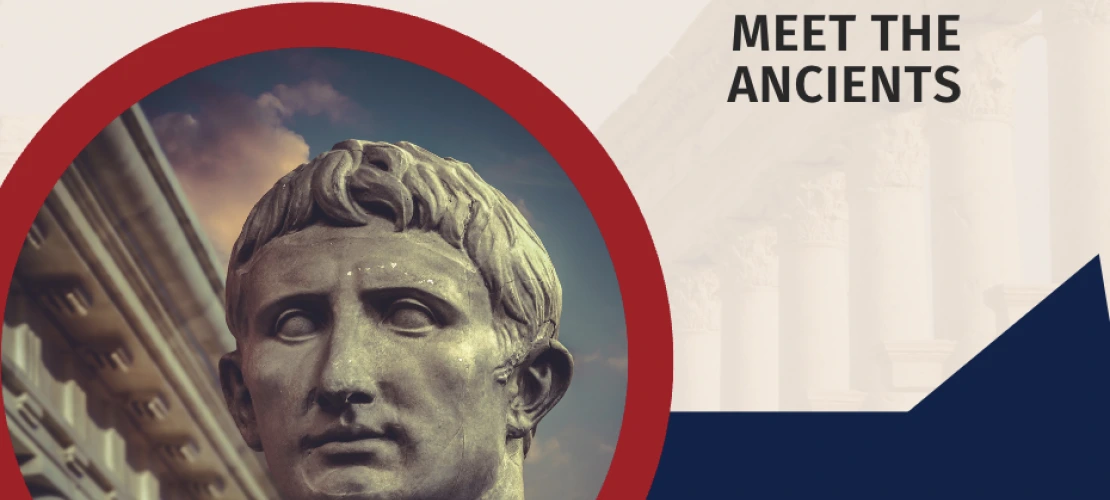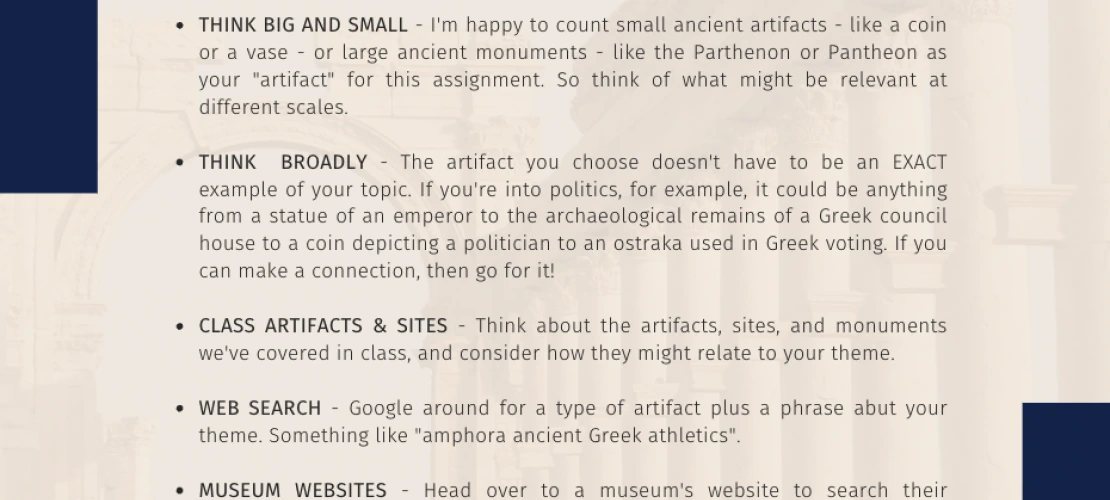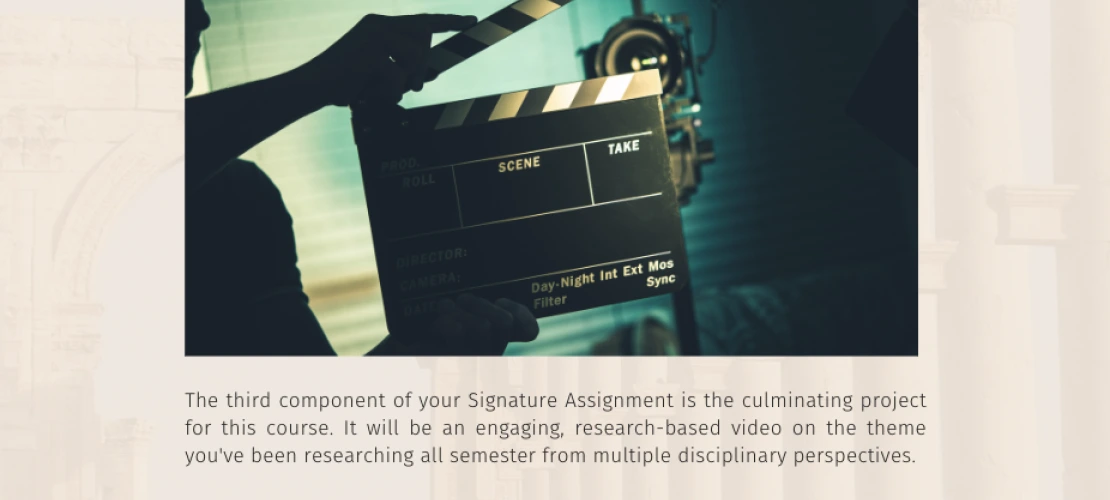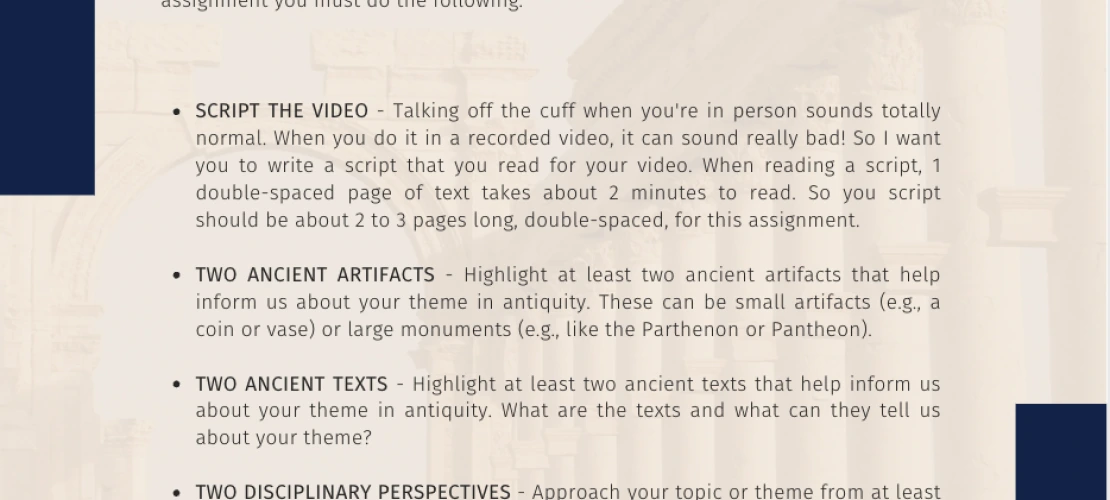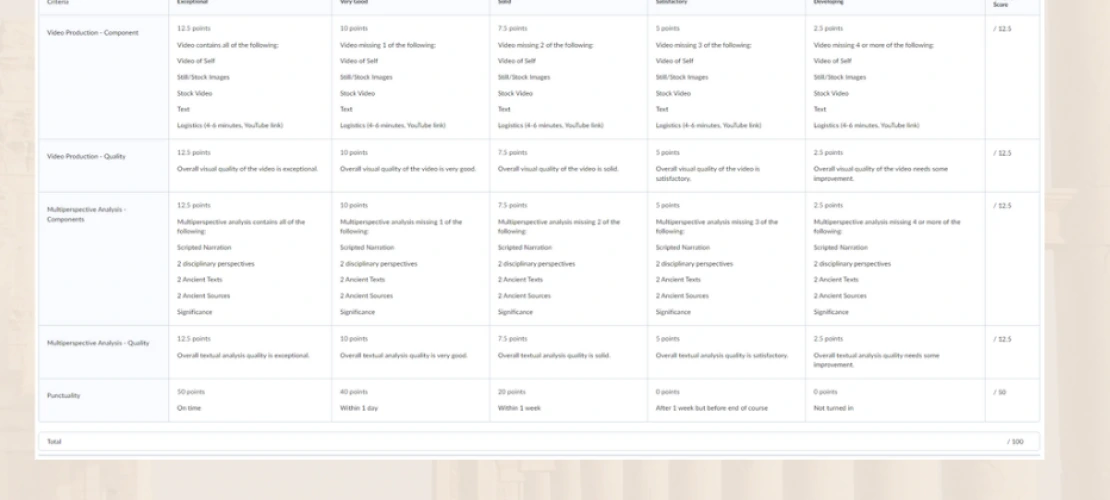Course Title: Meet the Ancients: Gateway to Greece and Rome (CLAS 160B1)
Instructor: Robert Stephan
Gen Ed Category: Building Connections
Gen Ed Attribute: World Cultures and Societies, Writing
Type of Assignment: Scaffolded project
Journey into the past to discover the worlds of the ancient Greeks and Romans. From democracy and republicanism to literature, philosophy, and art, the contributions of these two cultures serve as the foundation for much of what has been described as "western" culture. This course explores who these peoples were, how these civilizations developed, what ideas and institutions they created, and why the Greeks and Romans matter today.
Through this exploration into the Greco-Roman world, this course builds connections between the multiple types of evidence that scholars draw upon to paint a picture of the ancient past. Close readings of texts provide a humanistic perspective on classical culture; archaeological data inform us about social scientific trends in demography and economics; environmental evidence from ice cores, botanical remains, and soil samples enable a natural science perspective on the past; and some of the world's most famous objects - from the Venus di Milo to Grecian vases - allow for artistic insights.
Upon completing Meet the Ancients, students will not only have a better understanding of Greco-Roman history and culture, they will, above all, have a deeper understanding of the different perspectives used to approach ancient history and the skills to evaluate and synthesize diverse types of evidence.
Overview. In this Building Connections general education course, you'll synthesize the various disciplinary perspectives you've learned about during the semester in a scaffolded Signature Assignment. The overall goal of this Signature Assignment will be to create a video documentary about a topic you choose. You'll produce this documentary using Adobe Rush and/or Adobe Premiere Pro. The evidence for your documentary will combine both textual evidence from ancient literary sources and material evidence from ancient archaeological sources. You will then use those sources to approach your topic from at least two different disciplinary perspectives. In the end, you'll produce an engaging video meant for a broad audience that still maintains academic rigor and a reliance on ancient primary sources. In leveraging these sources from multiple disciplinary perspectives, you will be building connections across disciplines.
Assessment. There are three components to the project - a 500-1000 word written analysis of an ancient text, a short 1-2 minute video on an artifact, and a polished 4-6 minute video that illuminates your theme using ancient evidence from multiple disciplinary perspectives. The grading criteria, weight, and rubric for the Signature Assignment can be found on D2L.
With the Signature Assignment for CLAS 160B1: Meet the Ancients, my goal is to get students to do two things – teach themselves transferable skills and discover the joy of research. As it turns out, however, just telling 500 freshmen to go “discover the joy of research” doesn’t exactly get the crowd going. Instead, this Signature Assignment encompasses a semester long journey in which I try to provide just the right balance of guidance and freedom to empower students to learn for themselves.
The project itself begins on Day 1 of the class, when I talk about my own educational journey and about the differences between absorbing knowledge and producing knowledge. We conclude the day with a few activities to help brainstorm research ideas. Students might, for example, list their favorite activities outside of the classroom (e.g., sports, music, fashion, food, etc.) and then think about how they might intersect with classical antiquity. Each subsequent week, we spend at least part of one class learning a new “skill” that’s necessary to complete the final project. Over the 15 weeks, we’ll work on finding primary sources, unpacking the rhetorical situation, employing diverse disciplinary perspectives, writing for a popular audience, and learning to edit video. Once students have the experience doing these things collaboratively as a class, they have far more confidence employing these skills in their own assignments.
The way the Signature Assignment maps onto the course learning outcomes is relatively straightforward – students approach their topic from multiple disciplinary perspectives (BC); they focus their topic on some aspect of ancient Egypt, Greece, or Rome (WC&S); and they draft, edit, and finalize a script for their video (Writing). Along the way, however, students also pick up a variety of other important abilities that will be useful regardless of their major or career path: they learn research skills as they’re taught to discover 2,000-year-old primary sources for their topic; they develop the basics of textual and material analysis as they consider the rhetorical situation in which their sources were created; they learn to tailor their own writing to specific audiences; and they learn the technical skills behind editing video with Adobe Rush and Premiere Pro.
At the core of the assignment is the ability to approach a topic from multiple disciplinary perspectives. To model this, we crowd source an idea from the class and then work in groups to brainstorm all the different ways one could approach that topic. If, for example, the class suggested the Ancient Olympics as a topic, the Humanist group might highlight the mythological and religious underpinnings of the ancient games or the poems composed in honor of the victors. The Social Scientist group might investigate the economic dynamics of hosting the games or the political implications for participating city-states. The Artist group might look at the production techniques for the famous cult statue of Zeus at Olympia, and the Natural Scientist group could focus on the relationship between diet and health for the ancient athletes. Once again, the goal of this exercise is to model perspective-taking for the students by showing them how a single topic might be approached in vastly different ways. It’s the students’ job, then, to go develop and choose their unique perspectives through which to approach their own project topic.
As I reflect upon the Signature Assignment, I think there are several facets that are particularly rooted in the evidence-based research on teaching and learning. First, I believe that giving the students the freedom to focus on something they’re genuinely interested in is key. As recent studies have shown, this leads to students spending far more time working on the project and to better overall results (Hanewicz et al. 2017). Moreover, this centers the project within a student-centered, active-learning approach that has been shown to be effective (Deslauriers et al. 2019). Second, I think that collaboratively modeling the skills for the students is fundamental to the learning process. It has been shown that this gives them greater confidence in applying the skills themselves (Haston 2007). Moreover, the fact that they must adapt those skills to their own unique topic forces them to genuinely understand the process rather than just copy the results (Wilson et al. 2020). This modelling is part of the larger effort to scaffold the assignment across the entire semester, which itself has been promoted again and again in pedagogical research (Rosenshine 2012). Finally, education research has noted the benefits that stem from asking students to translate their learning into different formats and for diverse audiences (Gunel et al. 2009). Although students begin by writing traditional academic essays, the final project centers on a documentary video aimed at a broad, non-specialist audience. This not only forces them to understand the material so deeply they can reframe it for an entirely new audience (Pope-Ruark 2011), it also provides them with an engaging, tangible artifact that can serve as a testament to their academic and technical skills in the years to come.
Bibliography
Deslauriers, Louis et al. “Measuring Actual Learning Versus Feeling of Learning in Response to Being Actively Engaged in the Classroom.” Proceedings of the National Academy of Sciences - PNAS 116.39 (2019): 19251–19257.
Gunel, Murat, Brian Hand, and Mark Andrew McDermott. “Writing for Different Audiences: Effects on High-School Students' Conceptual Understanding of Biology.” Learning and Instruction 19.4 (2009): 354– 367.
Hanewicz, Cheryl, Angela Platt, and Anne Arendt. “Creating a Learner-Centered Teaching Environment Using Student Choice in Assignments.” Distance Education 38.3 (2017): 273–287.
Haston, Warren. “Teacher Modeling as an Effective Teaching Strategy.” Music Educators Journal 93.4 (2007): 26–30.
Pope-Ruark, Rebecca. “Know Thy Audience: Helping Students Engage a Threshold Concept Using Audience-Based Pedagogy.” International Journal for the Scholarship of Teaching and Learning 5.1 (2011).
Rosenshine, B. “Principles of instruction: Research-based strategies that all teachers should know.” American Educator 36.1 (2012): 12-39.
Wilson, Kristy J et al. “Modeling in the Classroom: Making Relationships and Systems Visible.” CBE Life Sciences Education 19.1 (2020).
Scroll through the assignment packet for CLAS 160B1 by clicking the left and/or right arrows on the images!
Suggested citation:
Stephan, R. (2024). Meet the ancients: Gateway to Greece and Rome signature assignment. University of Arizona High Impact Practices in General Education: Exceptional Signature Assignment Repository. https://hip.ge.arizona.edu/meet-ancients-gateway-greece-and-rome
This work is licensed under Creative Commons Attribution-NonCommercial 4.0 International
